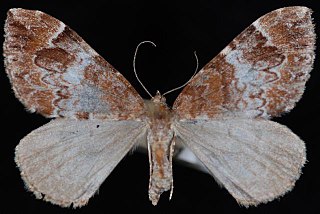
Halone is a genus of moths in the subfamily Arctiinae from southern Asia and Australia. The genus was erected by Francis Walker in 1854.

Ericeia is a genus of moths in the family Erebidae. The genus was erected by Francis Walker in 1858.

Mocis is a genus of moths in the family Erebidae. The genus was erected by Jacob Hübner in 1823.

Ericeia subsignata is a moth of the family Erebidae. It is known from Australia, including the Australian Capital Territory.

Ericeia inangulata, the sober tabby, is a moth in the family Erebidae. The species was first described by Achille Guenée in 1852. It is found in the Indo-Australian tropics of China, India, Sri Lanka, Myanmar, and the Marianas and Carolines, Fiji, Vanuatu, New Caledonia and Samoa.

Ericeia pertendens is a moth in the family Erebidae first described by Francis Walker in 1858. It is found from the Indo-Australian tropics to the Solomon Islands.
The Hulodini are a tribe of moths in the family Erebidae.
Ericeia elongata is a moth in the family Erebidae. It is found from the Indo-Australian tropics to New Guinea and Australia (Queensland). The habitat consists of lowland forests, including heath and alluvial forests.
Ericeia congregata is a moth in the family Erebidae. It is found in Angola, Cameroon, Cape Verde, the Comoros, the Democratic Republic of Congo, Gabon, Kenya, La Réunion, Madagascar, Mauritania, Mauritius, Sierra Leone, South Africa, Gambia, Uganda, Yemen, Saudi Arabia, India and Sri Lanka.

Ericeia amanda is a moth in the family Erebidae. It is found on Borneo, Sumatra and Peninsular Malaysia. The original description notes Adelaide, Australia as type locality, but the species is not known from Australia.
Ericeia rectifascia is a moth in the family Erebidae. It is found on Sumatra, Java and Borneo.
Ericeia korintjiensis is a moth in the family Erebidae. It is found on Sumatra, Java and Borneo. The habitat consists of forested areas up to altitudes of about 1,790 meters.

Ericeia eriophora is a moth in the family Erebidae. It is found from the Oriental tropics to the Philippines and Sulawesi.
Ericeia brunnescens is a moth in the family Erebidae. It is found on Borneo, Sumatra and Java.
Ericeia epitheca is a moth in the family Erebidae first described by Charles Swinhoe in 1915. It is found on New Guinea, where it has been recorded from Fergusson Island.
Ericeia goniosema is a moth in the family Erebidae. It is found in New Guinea and Australia, where it has been recorded from Queensland.
Ericeia leichardtii is a moth in the family Erebidae. It is found on Fiji, Tonga, the Loyalty Islands Samoa and in northern Australia.
Ericeia plaesiodes is a moth in the family Erebidae. It is found in Australia, where it has been recorded from Queensland, the Northern Territory and New South Wales.
Lecithocera sobria is a moth in the family Lecithoceridae. It was described by Edward Meyrick in 1904. It is found in Australia, where it has been recorded from New South Wales.

Dysstroma sobria, the 10-spotted rhododendron moth, is a species of geometrid moth in the family Geometridae. It is found in North America.








